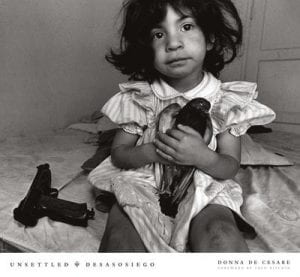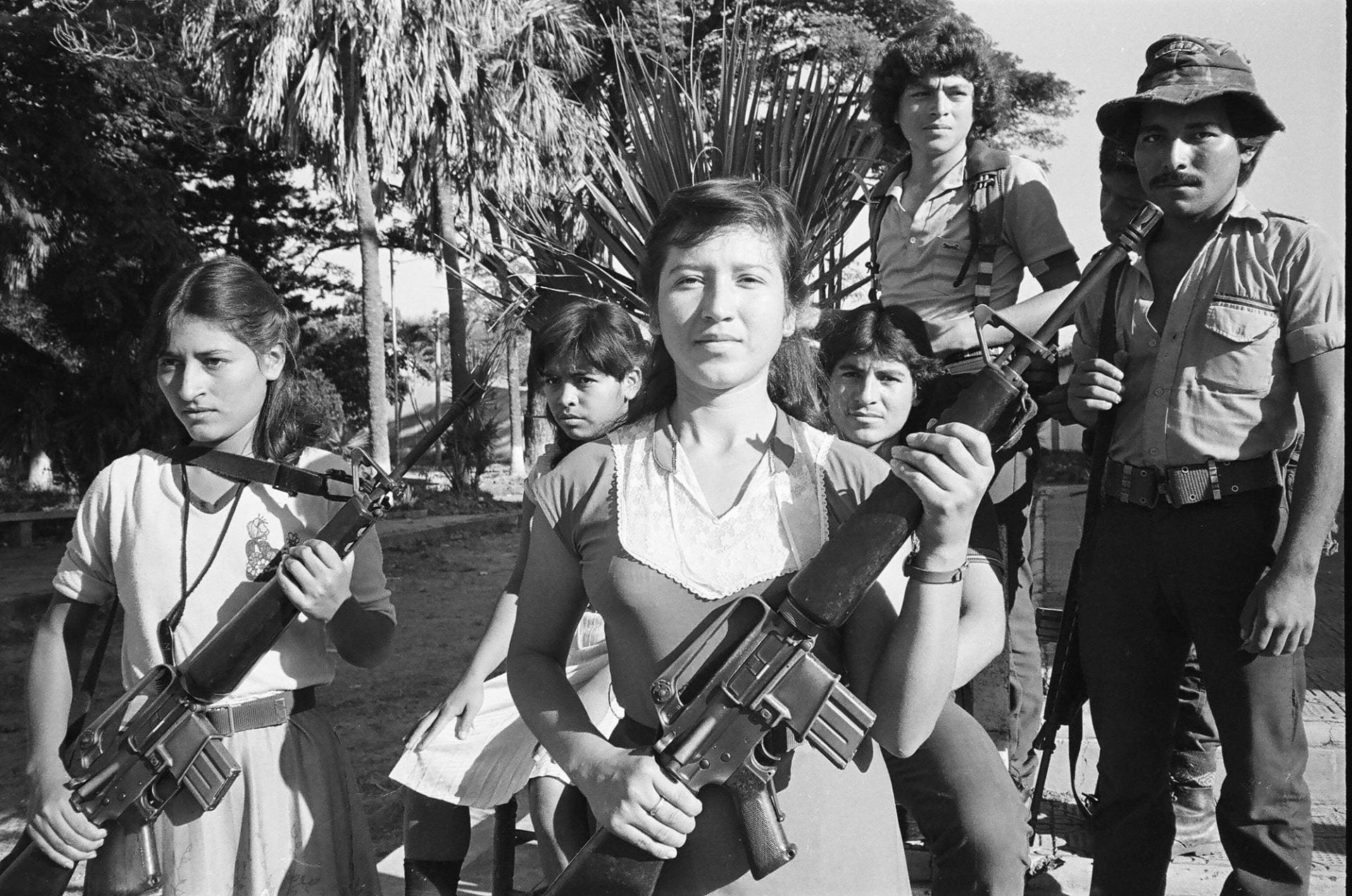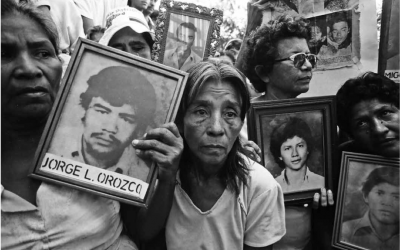A Review of Unsettled/Desasosiego, Children in a World of Gangs
Violent Legacies, Intimate Photos

Unsettled/Desasosiego, Children in a World of Gangs by Donna DeCesare (University of Texas Press, Austin, 2013, 164 pages)
Unsettled/Desasosiego is an honest book that recounts Donna DeCesare’s long relationship with Central America and its people in an intimate, personal fashion.
The photograph on page 19 is highly revealing. It captures the movement of people, the chaotic hubbub, the ongoing life of the town and—finally—some armed men who seem entirely out of place. On the left, a little girl embraces a wooden pole. She is the focal point of the image; she holds on to the pole to keep herself from falling and at the same time appears to be holding up the world so that it will not be swept away by the whirlwind. It is an intimate photo —the girl is lost in her fantasies—and DeCesare approaches her with great respect and delicacy.
There is something dreamy, slightly incongruent in that photo. The contrast between the sweet and inward-turning experience of the girl and the presence of the armed men is unsettling. It is evident that her fanciful dreaming could easily be turned into a nightmare.
In spite of the admiration and respect I have for DeCesare, I had some doubts when I heard that she had published a book about the children of violence. It is a prejudice that I carry with me after having seen innumerable photos of children with their large and tender eyes, photo-hooks seeking to entrap the readers, immersing them in easy emotions.
It was encouraging to discover that the photos in this book, product of decades of work, are the result of a dialogue, of an exchange, of shared personal experience.
Donna DeCesare, who is receiving Columbia University’s Maria Moors Cabot Award for outstanding journalism this fall, is a well known photojournalist. The most frequent error we photographers make is to publish photos for other photographers, complex photos that demonstrate the sophistication of our gaze. DeCesare’s book is not trying to impress anyone. She shows poetic photos of enormous beauty and sophistication, and she also has simple photos, which could be in a family album. All are necessary to recount this history.
The book’s subtitle is “Children in a World of Gangs.” Children are present in almost all of the images. There are photos of children taken in the 1980s and 1990s. These children have now ceased being children for a long time or perhaps are no longer living. To survive in this world is almost a miracle, and there are very few who have found a path other than violence. Children are messengers who cross time and generations, who carry with them the residues of the horrors they experienced.
Unsettled/Desasosiego is a book that hurts. Its photographs are testimonies of children whose childhood was mutilated, whose images are always made with enormous respect, without affectation or sentimentality. The text, written by DeCesare in a personal and committed voice, offers us a political and historic context that we need to understand the significance of the images.
DeCesare’s writing tells us how the counterinsurgency war of the 1980s in Central America, financed by the United States in blatant support of genocidal governments, left an indelible mark on these societies. And we come to understand that the rebels also committed terrible deeds. We learn that many of today’s gang members were yesterday’s victims. And we conclude that today’s children will probably perpetuate this cycle of violence.
The first part of the book discusses the 1980s civil war—fratricidal war—that tore through the social fabric and produced countless deaths and thousands of displaced people. The photos from this period display the euphoria, the worry, the fragility of civilians. DeCesare avoids graphic or violent photos; rather, her images bring us closer to the humanity of those portrayed and to their innermost emotions.
The second part of the book discussed Central America’s displaced people, how, as victims of the violence, they ended up living in the most violent neighborhoods of large American cities, especially in Los Angeles. The tragic destiny of many of those who emigrated is that they found themselves immersed in a new war when they sought a place that should have offered refuge and protection. DeCesare basically photographs the way people relate to each other, and tries at all cost to redeem them by demonstrating their most human and tender aspects.
The third section gives the book its title. Unsettled/Desasosiego is the construction of a society that does not have a focal point, a society of eternally displaced people. Gang members, the violent actors in today’s society, are citizens of violence, of marginality. They are not Americans in spite of the many cultural references they have constructed in the United States, but they are also not citizens of their own countries because their memories and their traditions were dynamited during a long confrontation without winners and a conflict that continues, seemingly without a solution. The images taken in Central America for the last chapter are the most disturbing in the book. Pain, fear and lack of hope emanate from the photos.
Unsettled/Desasosiego is a book that should be read slowly. The text becomes a revealing compass, a detailed testimony of encounters and misencounters of aspirations and frustrations.
Fred Ritchin’s preface is, as always, extraordinary. Ritchin is one of the most lucid thinkers, a visionary of the image. He makes an essential observation, namely, that DeCesare’s photos accomplish a goal much more important than that of a reporter who recounts a story to inform the world. These photos return memory to the people who are being photographed.
One of the most important uses of photography is to help construct a family album, a kind of rosary of memories and feelings that bestow identity, especially to those who have lost it. Unsettled/Desasosiego is a precious family album, a personal diary written with devotion and care.
The crisis of photojournalism is due not only to the radical democratization of photography. Certainly, now there are millions of people who have access to a camera and who use photography to communicate. Photojournalism is also losing relevance because we photographers have not understood that we are not the owners of photographic language (in the same way that writers are not the owners of the language that all of us use). We have forgotten that our mission is not to save the world nor to redeem it—that is true arrogance—and that no one has an obligation to listen to us.
Our task is much more modest: to tell personal stories —stories that are important to us—and do so with honesty. We should approach the lives of others on tiptoe, with enormous delicacy and respect, just as Donna DeCesare has done in Unsettled/Desasosiego.
Related Articles
A Search for Justice
In 2004, when I left Harvard and last saw you, I thought I would never learn the truth of what exactly happened to Carlos Horacio in the horrendous holocaust of the Palace of Justice in Bogotá. Yet fate was holding a tremendous surprise for my daughters and me, filled with…
Memory: Editor’s Letter
Editor's Letter Memory Irma Flaquer’s image as a 22-year-old Guatemalan reporter stares from the pages of a 1960 Time magazine, her eyes blackened by a government mob that didn’t like her feisty stance. She never gave up, fighting with her pen against the long...
A Search for Justice in El Salvador: One Legacy of Ignacio Martín-Baró
In the small rural town of Arcatao, Chalatenango, Rosa Rivera clung to the hope that one day she would find the remains of her disappeared mother and father and lay them to rest in peace. Others sought to exhume mass graves hoping to recover bodies of nearly 1,000 relatives massacred in the Río Sumpul. …




